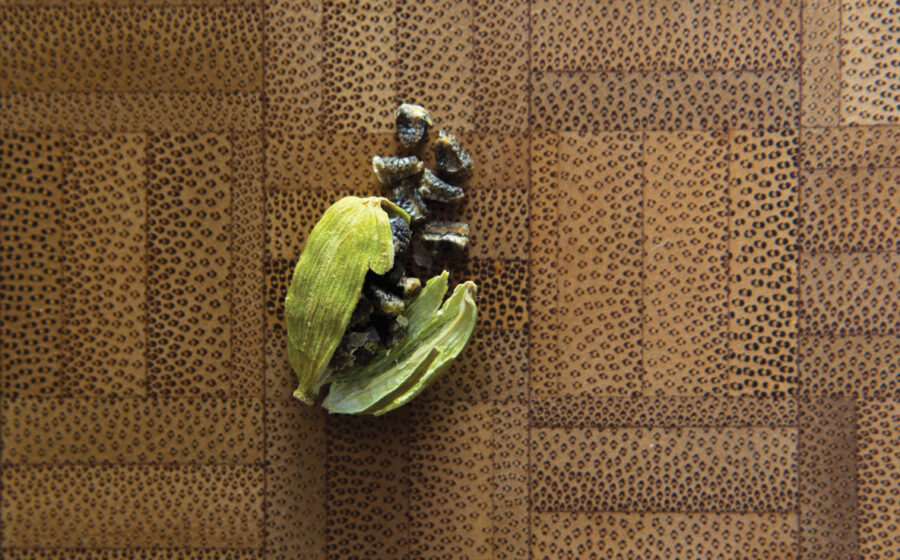[I]f you were to compare cardamom (Elettaria cardamomum) to a precious metal, it would be gold. Closely following saffron and vanilla bean, cardamom is one of the most expensive spices in the world. Cardamom comes in two main types: green and black. Black cardamom has a smoky quality and hearty, resinous flavor that is likened to camphor, and it is not as popular or valued as its green relative, also known as true cardamom, which is the focus here.
Mentioned in Egypt’s Ebers Papyrus, one of the oldest known medical documents dating back to 1,550 BCE, cardamom has traversed the globe with traders and travelers. Related to ginger, cardamom is indigenous to the Western Ghats of South India where it still grows wild in the Cardamom Hills and is cultivated on small farms and on large gated, heavily guarded plantations. The Middle East, Southeast Asia, and Europe are its main importers. Today true cardamom is grown across the globe, though, surprisingly, the majority of this ancient, aromatic, Asian pod is grown in Guatemala then shipped, in large part, to Arab countries.
On a recent visit to a cardamom-growing-region in Guatemala, I learned that German émigrés brought cardamom here around 1910. The region proved ideal for this plant: tropical, high elevations (2,000–5,000 feet), consistent rainfall, high humidity, stable temperatures, and plenty of indigenous Mayan farming families accustomed to labor-intensive manual harvests.
These triangular pods, containing tiny dark seeds, emit sweet, aromatic floral notes, particularly when crushed; the flavor is menthol-ish, reminiscent of eucalyptus with hints of citrus, yet distinctly its own.
The palm-like, leafy plant, which appreciates partial shade and grows between six and ten feet tall, is unusual in that the flowers and pods (fruits) are found on long thin shoots that grow at the base close to the soil. Harvest begins in August and except for a short rest in the cooler months of December and January continues through May. The plants produce fruit within three to four years then continue for four to six years. Delicate white flowers with bright pink markings appear throughout the year on the low lying shoots, which can grow to three feet in length. The flowers produce small, bright green pods that grow to approximately seven millimeters (about a quarter inch) and mature at such varying rates that one plant may be picked six times during a season. Harvesting requires workers to squat close to the ground and carefully handpick only nearly-but-not-quite-ripe pods. These triangular pods, containing tiny dark seeds, emit sweet, aromatic floral notes, particularly when crushed; the flavor is menthol-ish, reminiscent of eucalyptus with hints of citrus, yet distinctly its own.
Cardamom quality is determined by color and size but aroma is of utmost importance. The spice is further split into four categories: whole pods, crushed and broken pods (mixed), seeds (decorticated), or powder. Which grades and format you want is determined by the intended use, but if possible purchase whole pods or a mix of whole and crushed as the volatile oils locked inside both pods and seeds will begin to dissipate once exposed to air. Seeds are excellent options as they are usually the most cost-effective.
In India and neighboring countries where masala chai is a cultural staple, cardamom is an essential ingredient in countless savory, sweet, and wellness recipes. It has been highly valued for its lengthy list of medicinal properties, enjoying ayurvedic superstar status for many millennia. It is known to, among other things, stimulate appetite, assist with digestion, and sweeten the breath. In the Middle East, cardamom is the key ingredient in Arabic coffee, synonymous with hospitality and consumed in copious quantities.
In North America where the popularity of chai is rapidly increasing, cardamom can be found in many mixed spice (masala) and tea (chai) blends. The spice is certainly not limited to this application; many tea blenders use it creatively, but with a light touch, as the cost can be somewhat prohibitive. Although coffee houses in the States have not embraced Arabic coffee, which is usually served with dates for sweetness, it’s worth exploring. A standard recipe calls for two to three tablespoons of green coffee beans, lightly roasted on-site then ground, mixed with two teaspoons of ground cardamom, and simmered in two cups of water. Just before serving, top with a pinch of crushed cardamom. Who wouldn’t appreciate a cup of green gold?
—Linda Villano is a co-founder of Serendipitea.
















